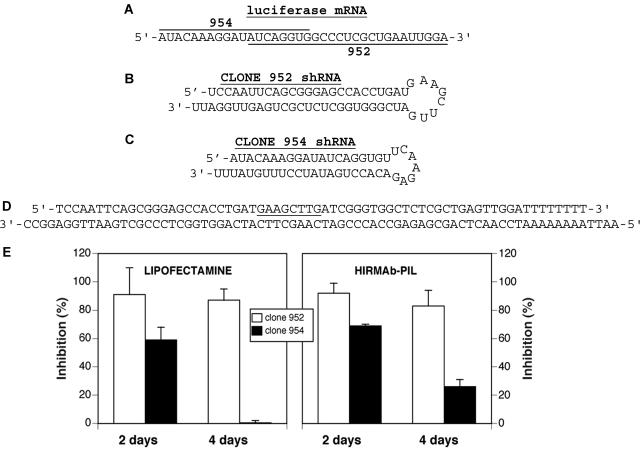FIG. 2.
A: Target sequence of the luciferase mRNA. The sequence targeted by the clone 952-derived shRNA is underlined, and the sequence targeted by the clone 954-derived shRNA is overlined. B and C: Sequences and secondary structure of shRNAs encoded by clone 952 and clone 954, respectively. D: For the construction of clone 952 shRNA expression vectors, complementary ODNs are synthesized and annealed. The sequence complementary to the forward ODN contains 4-nucleotide overhangs to the EcoRI and ApaI restriction sites at 5′- and 3′-end, respectively, to direct subcloning into the cohesive ends of the expression vector driven by the U6 promoter shown in Figure 1A.37 The T5 terminator sequence for RNA polymerase III is introduced in the sequence of the ODNs. E, left: Percent inhibition in luciferase activity at 2 and 4 days caused by cotransfection at zero time of the U87 cells with clone 790, a pCEP4-derived luciferase expression plasmid,48 and shRNA clones 952 or 954 plasmid DNA, respectively. There is no inhibition of luciferase expression in the cells transfected with clone 954 at 4 days. E, right: Percent inhibition in luciferase activity at 2 and 4 days caused by exposure of the U87 cells to PIL encapsulated clone 952 and 954, respectively. Cells were exposed to lipofectamine and clone 790 plasmid DNA for 4 h, washed, and the HIRmAb-PILs carrying either clone 952 or clone 954 were added, and the cells were incubated for 2 or 4 days before measurement of luciferase activity. All data are mean ± SEM (n = 3 dishes per point). Reproduced with permission from Zhang et al. In vivo knockdown of gene expression in brain cancer with intravenous RNAi in adult rats. J Gene Med 5:1039–1045. Copyright © 2003, John Wiley & Sons, Ltd. All rights reserved.44

